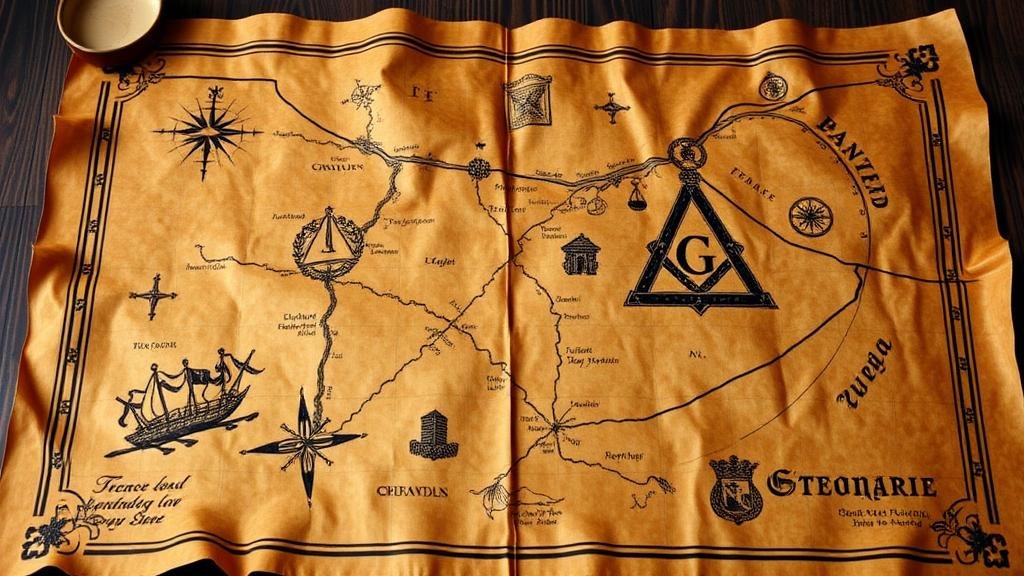Recognizing Treasure Maps Embedded in Religious or Masonic Texts
Recognizing Treasure Maps Embedded in Religious or Masonic Texts
The notion of treasure maps hidden within religious or Masonic texts is a fascinating topic that intertwines history, symbolism, and the quest for knowledge. These texts often contain layers of meaning, requiring careful examination to uncover the metaphorical treasures they hide. In this article, we will explore how to recognize these treasure maps, the symbolism involved, and relevant historical examples.
Understanding the Concept of Treasure Maps
Treasure maps–both literal and metaphorical–are guides that lead to invaluable truths or knowledge. In religious and Masonic contexts, the treasure often symbolizes spiritual enlightenment, moral lessons, or hidden wisdom rather than physical wealth. These texts serve as a roadmap for believers, offering pathways to greater understanding and personal development.
Historical Context and Symbolism
To recognize treasure maps in these texts, one must first grasp their historical context. Many religious and Masonic writings emerged during periods of persecution and secrecy, leading authors to encode their teachings in allegory and metaphor. For example, the Bible contains numerous parables and poetic structures that require interpretation beyond their literal sense.
- The Bible: Stories such as the parable of the hidden treasure in Matthew 13:44 illustrate how treasure is used as a symbol for the Kingdom of Heaven, embodying the idea that valuable truths are often concealed.
- Masonic Texts: The degrees of Freemasonry often incorporate symbols like the compass and square, which guide members toward moral and ethical behavior. Understanding these symbols can reveal deeper insights into Masonic teachings.
Key Indicators of Hidden Treasures
Recognizing treasure maps within these texts often involves identifying key indicators, such as recurring symbols, allegorical content, or mysterious references. Here are some critical markers to look for:
- Symbolism: Look for repeated symbols that may represent broader concepts, such as light representing knowledge or darkness symbolizing ignorance.
- Numerology: Many religious and esoteric texts employ numbers with significant spiritual meanings. For example, the number seven often denotes completion or perfection in biblical texts.
- Archetypal Themes: Universal themes such as the journey, initiation, and rebirth are common in both religious and Masonic narratives and may indicate a map leading to spiritual growth.
Case Studies: Religious and Masonic Texts
Several texts have been dissected to reveal hidden meanings. One notable example is the Book of Revelation, which contains vivid imagery and symbolism that many scholars have examined in search of prophetic messages and deeper meanings regarding spirituality and morality.
Similarly, Masonic texts, such as Morals and Dogma by Albert Pike, serve as a treasure map for Freemasons. Pike’s work delves into the spiritual significance of Masonic symbols and provides insights into the moral codes that guide members in their lives.
Practical Applications: How to Decode These Texts
To effectively recognize and interpret treasure maps in religious or Masonic texts, consider the following approaches:
- Conduct a Close Reading: Analyze the text by examining word choices, recurrent phrases, and the structure of arguments presented. Pay attention to any peculiar terms or concepts that seem out of place.
- Use Supplementary Resources: Engage with commentaries, scholarly articles, and historical analyses that can provide additional context and interpretations that may not be immediately apparent.
- Join Study Groups: Collaborating with others, whether in a religious setting or among fellow Masons, can deepen understanding through shared insights and diverse interpretations.
Conclusion: The Search for Spiritual Treasure
Recognizing treasure maps embedded in religious or Masonic texts involves more than mere reading; it is an interpretative journey that benefits from patience, critical thinking, and collaboration with others. By identifying symbolic language, allegorical narratives, and key indicators, individuals can uncover profound wisdom that lies at the heart of these historical texts.
Ultimately, the quest for spiritual treasure is an ongoing process, inviting followers to engage with their legacy, question interpretations, and continuously seek deeper understanding. Just as one might not find gold at the end of every map, the true treasure often lies in the knowledge and insight gained along the way.


